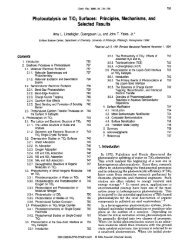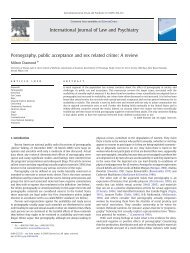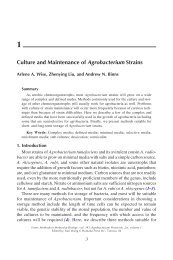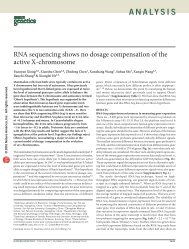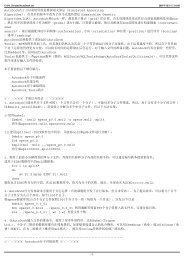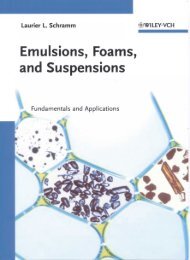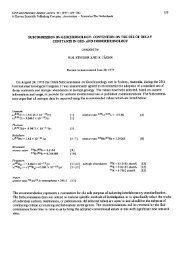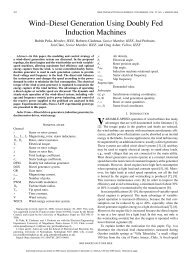Create successful ePaper yourself
Turn your PDF publications into a flip-book with our unique Google optimized e-Paper software.
Cell<br />
362<br />
use both the perforin/granzyme and FasL/Fas pathways, Fas gene are not tumorigenic. However, the families of<br />
whereas the Th1-type CD4 T cells preferentially use the these patients sometimes have histories of Hodgkin’s<br />
FasL system. Whether particular CD8� T cells and NK lymphoma (Fisher et al., 1995). The abnormal survival<br />
cells have any preference for using the perforin/gran- of the lymphocytes may allow the cells to accumulate<br />
zyme or FasL/Fas system on specific target cells re- mutations that lead to malignancy. Genes for death fac-<br />
mains to be studied. Furthermore, CTLs in mice deficient tors and their receptors, such as FasL and Fas, may<br />
in both the perforin and FasL systems show some resid- therefore be regarded as tumor suppressor genes. On<br />
ual cytotoxicity in long-term assays (Braun et al., 1996), the other hand, when the system overfunctions, it<br />
suggesting that yet another death factor(s), perhaps TNF causes tissue destruction and kills the animals. When<br />
or TRAIL, functions as a CTL effector under these condi- an agonistic anti-Fas antibody or recombinant FasL was<br />
tions. injected into mice to activate the Fas system in vivo, the<br />
Immune Privilege<br />
mice were quickly killed <strong>by</strong> liver failure with symptoms<br />
Cellular immune response reactions and their associ- similar to fulminant human hepatitis (Ogasawara et al.,<br />
ated inflammatory responses can cause nonspecific 1993; Tanaka et al., 1997). Fulminant hepatitis is known<br />
damage to near<strong>by</strong> tissues. Although most organs can to be caused <strong>by</strong> abnormally activated T cells, and the<br />
tolerate such inflammation, some, such as the eye and transformation of hepatocytes with hepatitis B virus or<br />
testis, cannot. These organs, therefore, have a mecha- hepatitis C virus causes the up-regulation of Fas expresnism<br />
to protect themselves against dangerous and unsion. These results suggest that under normal circumwanted<br />
immune reactions. These organs are called “im- stances, CTLs recognizing viral antigens expressed on<br />
mune privilege sites” and are able to support allogenic the cell surface of infected hepatocytes are activated<br />
and xenogeneic tissue transplants. Initially, it was through the T cell receptor and kill the hepatocytes via<br />
thought that immune privilege is maintained <strong>by</strong> pre- the Fas/FasL system. If this killing process works propventing<br />
the activated cells from entering the organs. erly, it benefits the organism. However, when the system<br />
However, another attractive mechanism has recently is exaggerated, it may lead to fulminant hepatitis. It is<br />
been proposed (Bellgrau et al., 1995; Griffith et al., 1995). possible that other CTL-induced autoimmune diseases<br />
That is, although the activated inflammatory cells can such as graft-versus-host disease, AIDS, and insulitis<br />
enter these organs, they are immediately killed <strong>by</strong> FasL are also mediated <strong>by</strong> the Fas system.<br />
expressed in the organs (Figure 3C). The constitutive Various cancer patients produce TNF� in a soluble<br />
expression of functional FasL has been found in the form, and it works like a cachectin to induce systemic<br />
corneal epithelium and endothelium, iris, and ciliary cells tissue damage. Similarly, the soluble form of FasL was<br />
of the eye, as well as in the Sertoli cells of the testis. found in the sera of patients with NK lymphoma or large<br />
When the eyes of wild-type mice were infected with granular lymphocytic leukemia (LGL) of the NK or T cell<br />
herpes simplex virus (HSV-1), very few inflammatory type (Tanaka et al., 1996). The leukemic cells themselves<br />
cells were found associated with the retina, while mas- were found to express functional FasL on their surfaces.<br />
sive inflammation was observed in the retina of gld mice, These patients often show systemic tissue damage such<br />
which have a defect in FasL. Furthermore, while testes as hepatitis and neutropenia. Since hepatocytes and<br />
expressing functional FasL survived when transplanted neutrophils are particularly sensitive to Fas-mediated<br />
under the kidney capsule of allogenic animals, testis apoptosis, it is possible that the systemic tissue damage<br />
grafts from gld mice were rejected. These findings indi- observed in these patients is due to FasL in their serum<br />
cate that FasL accounts for at least part of the immuneprivileged<br />
nature of the eye and testis and suggest a<br />
use for FasL as an immunosuppressive agent to target<br />
or to FasL expressed on the circulating leukemic cells.<br />
activated effector cells in transplantation. In fact, when<br />
islets of Langerhans were cotransplanted with synge-<br />
Conclusions and Perspectives<br />
neic myoblasts expressing functional FasL, they were Many growth and differentiation factors regulate prolif-<br />
protected from immune rejection and were able to main- eration and differentiation of mammalian cells during<br />
tain normoglycemia for a substantial period in a mouse development. So far, three death factors (TNF, FasL,<br />
model system for diabetes (Lau et al., 1996). Similarly, and TRAIL) and four death factor receptors (Fas, TNFR1,<br />
several groups have recently found that some tumor DR3/Wsl-1, and CAR1) have been identified. Loss-of-<br />
cells become resistant to Fas-induced apoptosis and function mutations in the Fas system, lpr and gld mice,<br />
constitutively express FasL (Hahne et al., 1996; Strand illustrated the importance of this death factor system in<br />
et al., 1996). FasL expressed on tumor cells then coun- maintaining mammalian homeostasis, specifically in the<br />
terattacks CTL and NK cells <strong>by</strong> binding Fas on their life and death of lymphocytes. It is possible that many<br />
surfaces to cause apoptosis. This mechanism may also more death factor and receptor systems that regulate<br />
account for the ability of tumor cells to evade immune apoptosis in a tissue-specific manner will be found in<br />
destruction.<br />
the future. Growth and differentiation signals are medi-<br />
A Double-Edged Sword<br />
ated <strong>by</strong> the phosphorylation and dephosphorylation of<br />
As long as death factors are appropriately expressed, proteins, as well as <strong>by</strong> small second-messenger molethey<br />
will be useful in maintaining homeostasis. However, cules such as cAMP and phosphatidyl inositol. These<br />
if the system under- or over-functions, it will have delete- signals are reversible in most cases. On the other hand,<br />
rious effects. Loss of function causes hyperplasia, such the apoptosis signal triggered <strong>by</strong> death factors is irre-<br />
as lymphoproliferation. The lymphocytes accumulated versible; that is, a protease cascade is activated <strong>by</strong> the<br />
in patients carrying the heterozygous mutation in the death signal, and the proteases cleave various cellular





